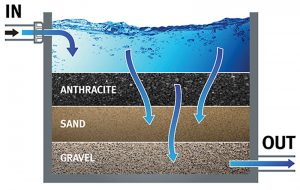Living in Southern California, I can’t help but look at the beautiful ocean and think, “No water?” Of course I know seawater is undrinkable, and yet I still ask myself, “why?”
Water usage restrictions are mentioned everywhere in media and around water coolers. Most people think of their baths, showers and brown-green lawns when they talk about saving water and the restrictions. However, as a member of the food and beverage niche at GHJ, I can’t help but think about all of the manufacturing processes (food and otherwise) that require massive amounts of water for production and cleaning.
There may be hope for some as water restrictions may be lifted in Northern California due to substantial rainfall this rainy season with some places seeing up to 12 inches. Southern California was not so lucky; with sunny skies minus a few rainy days, el Nino was a disappointment for most. According to Governor Brown’s office, several water-use restrictions will remain permanent for the foreseeable dry future, including practices deemed wasteful such as watering sidewalks.
There does seem to be a very large untapped source of water right in our backyard: the Pacific Ocean. Desalination is a process which converts salty ocean water into potable water. The process of doing this involves several methods, all of which require massive amounts of energy and a large infrastructure project to get them off the ground and running. There is a desalination plant in Santa Barbara, which has been functioning on and off for several years and is planning on being retrofitted by October 2016 to provide over 3 million gallons of potable water per day. There is also the $1-billion project in Carlsbad, CA, called the Claude “Bud” Lewis Carlsbad Desalination Plant, which has been producing upwards of 50 million gallons of potable water per day since it opened in December 2015.
Desalination is an expensive endeavor, however, with the cost per acre-foot of water produced being $100 more than recycled water and $1,000 more than reservoir water. But it also costs around $100 less than importing water from outside of San Diego County, which might make it a much better solution than trucking in our water in the long run.

Other problems exist for desalination, though, such as the briny waste that is produced. As the ocean water goes through the desalination process, half of the water is extracted as drinking water while the other half flushes away all of the salt and minerals that came in with the original ocean water. Next, desalination plants like the one in Carlsbad utilize a next-door power plant to combine intake cooling water with the briny waste and lower its overall salt concentration before it exits the plant as seawater again. If the water is too salty, it creates harsh living environments near the output flows.
After all of these issues, the 50 million gallons produced per day provide only around 7 percent of San Diego County’s water usage. If desalination is the future, then it’s going to be costly and it’s going to require a lot of investment.
…
About Alexander Brown (Senior Associate, GHJ)
Alexander Brown is a senior associate auditor at GHJ and has been with the firm more than two years after serving as an intern during the summer of 2012. Prior to officially joining the Firm in 2013, he worked as both a senior accountant and bookkeeper for various firms. He is a licensed CPA in the State of California and co-founder of the nonprofit MRSA Foundation. He holds a bachelor’s in Accountancy from California State University, Northridge.

